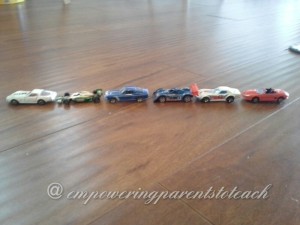Math Connections: Ten Little Caterpillars by Bill Martin Jr.
Aside from learning cardinal numbers (our counting numbers), such as one, two, three, etc., kids also learn to use ordinal numbers such as first, second, third, and so on. Bill Martin Jr.’s book Ten Little Caterpillars is the perfect book to introduce ordinal numbers to your child!
In this book, we meet ten caterpillars. Each caterpillar is introduced one at a time and referred to by it’s position or ordinal number. For example, we meet the first caterpillar, then the second caterpillar, all the way until the tenth caterpillar who eventually turns into a butterfly. The sentences are very short and have a rhyming pattern. This makes the book easy to read and allows you focus on the new concept of ordinal numbers. If your child already knows ordinal numbers have your child predict what will come next in the pattern. This book is a great resource to reinforce the idea for your child!
How to extend this:
- When you are walking up the stairs, have your child say out loud, “First step, second step, third step…” until you reach the top.
- Line up a group of toys (cars, action figures, blocks, dolls,) and ask your child questions such as, “Which car is third in line?”. If your child needs help, show him or her how we start on the left for the first car, the next one is second, the next one is the third car.
- When you are playing a game, state who is going first, second, third, etc.
- If you are playing baseball outside, for example, you may keep track of the pitches you threw- first pitch, second pitch, third pitch, and on.
- Making a salad? Tell your child, the first step is wash the lettuce, the second step is slice the tomato, third step is cut the carrots, etc. Or, use ordinal numbers when you are following a recipe.
-
Toys around the house:
Melissa & Doug Caterpillar Gear Toy
(Bonus: This toy also practices motor skills, color recognition, and spacial skills)
- There are so many possible ways to use ordinal numbers. Anything in order can be identified with an ordinal number. Keep your eye out for those opportunities and include your children. It won’t take them long to catch on!
Teaching Tip: These activities show children how ordinal numbers are used in everyday life. It puts the skill in context of how it is actually used, versus a contrived experience or worksheet. Real life application gives the child a better understanding of the concept and allows the child to later extend that knowledge to new situations.
Science Connections
In the book we also see:
- The caterpillars eat leaves, flowers, and vegetables.
- One caterpillar build a chrysalis.
- The caterpillar becomes a butterfly.
- The end of the book shows art work of different kinds of caterpillars and what they look like when they become a butterfly or moth.
All of these things can spark conversation about the life cycle of caterpillars!
Enjoy the story!
This post contains affiliate links. If you make a purchase on Amazon from this link, I receive a small percentage of the sale at no extra cost to you.
Amazon links:
Ten Little Caterpillars by Bill Martin Jr.




